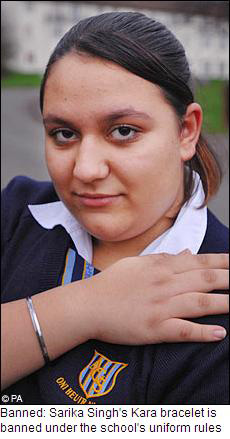 A simple steel wrist bangle means as much to Sarika Watkins-Singh, 14, as it does to the England spin bowler Monty Panesar, the High Court was told yesterday.
A simple steel wrist bangle means as much to Sarika Watkins-Singh, 14, as it does to the England spin bowler Monty Panesar, the High Court was told yesterday.
The 'kada' is not a piece of jewellery - it is an important religious symbol worn by Sikhs, including the England cricketer Monty Panesar, said Sarika's lawyers.
Mr Justice Silber said that he would like to see one of the bangles – known as the kara – during the hearing, which is set for three days.
In the meantime, Helen Mountfield, Sarika's counsel, referred the judge to a photograph of Panesar wearing the kara as one of the symbols of the Sikh faith.
The Punjabi-Welsh girl, from Cwmbach, near Aberdare, South Wales, claims that she was the victim of unlawful discrimination when she was excluded from Aberdare Girls' School last November after refusing to remove the bangle.
The school, at which Sarika was the only Sikh among 600 girls, does not permit jewellery other than wristwatches and ear studs.
In February, Sarika enrolled at another school, Mountain Ash Comprehensive, which allows her to wear the kara. Her mother, Sinita, 38, has said that, although Mountain Ash is a good school, her daughter's education suffered as a result of the move, in the build-up to her GCSEs.
Last Friday, the family travelled to 10 Downing Street to hand in a petition, calling on Gordon Brown to intervene in the matter "to show discrimination is totally unacceptable".
The petition gained the backing of 150 gurdwaras – the main Sikh religious institutions – and more than 200 Sikh organisations and 70 non-Sikh organisations. More than 100 MPs also offered support.
Liberty, the human rights group, which is supporting Sarika's case, claims that Aberdare Girls' School breached race, equality and human rights laws by not allowing her to wear the kara.
Ms Mountfield said that the kara was one of the five Ks of Sikhism, the others being the kesh (uncut hair), the kanga (wooden comb), the kaccha (specially designed shorts) and the kirpan (sword). The girls' school allowed for no exceptions to its uniform policy and there was no mechanism for seeking exceptions on cultural or religious grounds.
Sarika was taught separately for some months – "in educational and social segregation during school hours" – before being excluded for a day, then for five days and finally indefinitely, Ms Mountfield said.
The central legal issue was whether the school's policy amounted to unlawful discrimination under the Race Relations Act 1976, the freedom of religion provisions of the Equality Act 2006 and the Human Rights Act 1998.
Ms Mountfield cited a House of Lords decision 25 years ago, which had never been questioned, that a Sikh boy was subjected to indirect race discrimination when he was told he could only attend a school if he cut his hair and ceased wearing a turban.
Mr Justice Silber said that the only issue of fact in the case seemed to be whether Sarika was actually obliged by her religion to wear the kara. Ms Mountfield said it would not be right for a secular court to try to decide such an issue. The fact was that Sarika regarded herself as being under an obligation. The question was whether it was more disadvantageous to her to be told to remove the kara than it would be for another pupil to be told to remove a bangle.
The case continues.
-By Frances Gibb, Legal Editor

